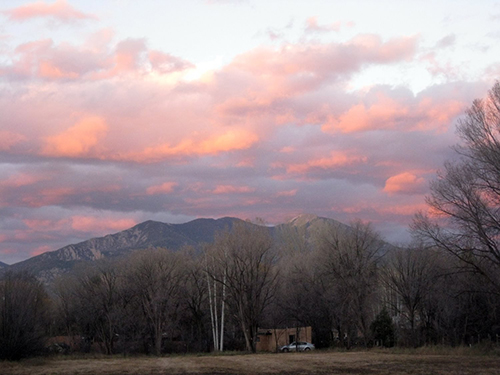
| Taos Studio | Photos | Poetry | Trombone Class | Miscellaneous |
Land of Journeys Ending
(for baritone/counter tenor, baritone, flute (with piccolo and alto flute,)
trombone, piano, and three percussion
4. Historical and Ethnological Background
6. Text in Spanish and English
Land of Journeys’ Ending was completed in 1974 and premiered in 1976 at the University of Pennsylvania by the new music ensemble Relâche conducted by Joseph Showalter.
![]()
2. The Score
Click here to download the PDF score. It should be printed on large paper, 17 x 22 inches.
(43.5 x 55.5 cm.)
![]()
3. The Video Score
This recording was made in 1976. The recording quality was poor and further deteriorated over the years. We've restored it as best as we can. Some passages or sounds in the score are inaudible. Page 6 is a full page graphic score we had to chop up to put in the video. As such, some parts of page 6 might at first be a bit confusing to follow. We recommend reading the historical and ethnological background of the work and the Spanish/English text below before listening to the video score.
![]()
4. Historical and Enthnological Background
Out of
the desert floor of Northern New Mexico rises a rugged, stark
mountain range called the Sangre de Christos. The isolation of the
sparsely populated mountains is dotted with small adobe villages
containing descendants of the original Spanish settlers of New
Mexico from 400 years ago.
Some of the villages are so isolated that a few inhabitants
still speak Spanish with elements of a dialect stemming from the 16th
century.
After Mexico gained independence from Spain in 1821, the Church withdrew most of the priests from New Mexico. The men in these small, isolated communities eventually came together in the absence of a priest and dedicated themselves to the purpose of providing mutual aid and charity. They called themselves Los Hermanos de la Fraternidad Piadosa de Nuestro Padre Jesús Nazareno, or colloquially Los Hermanos de Luz (the Brothers of Light,) or simply Los Penitentes.
In
addition to community service, they revived a long Christian
tradition of passion plays in a series of rituals and
processions over five days druing the Easter week.
These rituals allude to the region's Franciscan heritage,
including self-mortification and devout reenactments of the
crucifixion accompanied by songs of praise called Alabados.
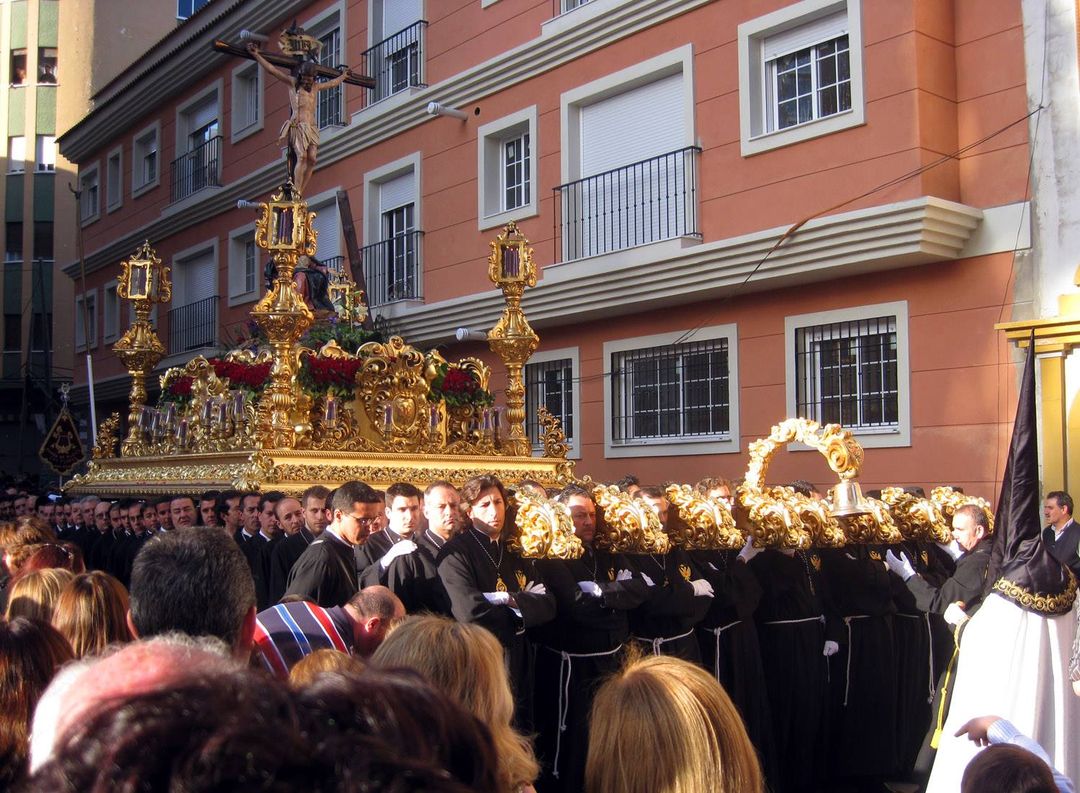 Penitent
Easter week processions are a tradition that has existed for
centuries in Spain. Catholic religious brotherhoods
(hermandad) and fraternities perform penance processions on the
streets of almost every Spanish city and town during the last week
of Lent, the week immediately before Easter. The Spanish
processions often demonstrate the oppulence and power of the Church,
while the Penitentes' riturals in New Mexico find their origins in
the Franscision modesty and poverty of a moutain farmer culture.
At the right is our photo of one of the lavish Spanish processions
in Malaga.
Penitent
Easter week processions are a tradition that has existed for
centuries in Spain. Catholic religious brotherhoods
(hermandad) and fraternities perform penance processions on the
streets of almost every Spanish city and town during the last week
of Lent, the week immediately before Easter. The Spanish
processions often demonstrate the oppulence and power of the Church,
while the Penitentes' riturals in New Mexico find their origins in
the Franscision modesty and poverty of a moutain farmer culture.
At the right is our photo of one of the lavish Spanish processions
in Malaga.
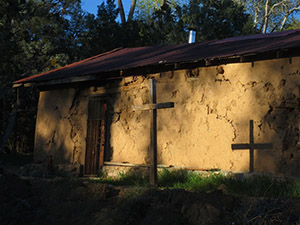 In
New Mexico, the Penitentes meet in small,
almost windowless adobe buildings called moradas for their
meetings and rituals. On
the right is my photo of a little known morada in a dusk light in
Valdez, NM.
In
New Mexico, the Penitentes meet in small,
almost windowless adobe buildings called moradas for their
meetings and rituals. On
the right is my photo of a little known morada in a dusk light in
Valdez, NM.
The
Penitentes’ architecture and livelihood stem from the stark, simple,
pastoral lives of mountain farmers. The simple voice of the wind,
the call of a mourning dove, or the color of the earth reflect their
devotion. One need only
hear their haunting alabados or the stark, terse wailing of their
rustic wooden flutes and ratchets piercing the night air of their
outdoor rituals to be convinced of this.
Later in
the 19th century the Church returned to NM and attempted to suppress
the Penitentes who responded by becoming something of a secret
society. This is why the
moradas that remain today are almost windowless.
It also reflects their humble desire for privacy in their
religious expression.
In January 1947, the Brotherhood and the Church reconciled and the Penitentes were officially recognized and sanctioned as a lay organization by the Archbishop in Santa Fe. By that time the membership had dropped radically due to demographic and social changes created by WWII. Today the Brotherhood remains small but continues as a charitable organization that still practices somewhat modified forms of their rituals. They are one of the most beautiful and fragile parts of New Mexico’s Hispanic culture.
 El
Santuario de Chimayó north of Santa Fe, NM, is a site that helps one
understand the Franscian culture out of which the Penitentes
evovled.
A small room at the side of the chapel called El Pocito (the
little well) contains a round pit, the source of "holy dirt" (tierra
bendita) that is believed to have healing powers. An adjacent Prayer
Room displays many ex-votos, photographs, discarded crutches, and
other testimonials of those purportedly healed. Devotees also leave
photos of their children and spouses in the military with the hope
that the Santuario will bring them home safely.
El
Santuario de Chimayó north of Santa Fe, NM, is a site that helps one
understand the Franscian culture out of which the Penitentes
evovled.
A small room at the side of the chapel called El Pocito (the
little well) contains a round pit, the source of "holy dirt" (tierra
bendita) that is believed to have healing powers. An adjacent Prayer
Room displays many ex-votos, photographs, discarded crutches, and
other testimonials of those purportedly healed. Devotees also leave
photos of their children and spouses in the military with the hope
that the Santuario will bring them home safely.
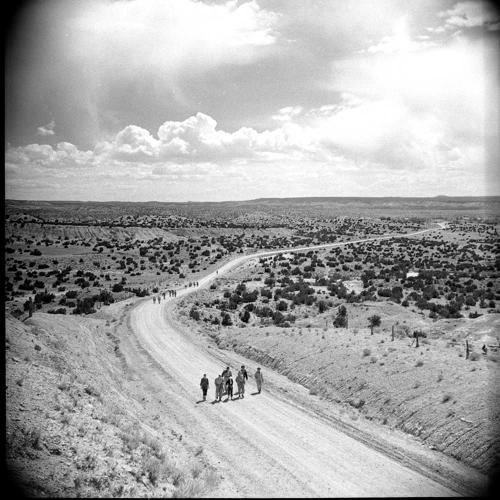 During
the 19th century, a tradition began of pilgrimages on foot to the
Sanctuario during Easter week. In 1946, Conrado Vigil fulfilled a
vow to make a 120 mile pilgrimage to Chimayo from his home
in Belin, NM if he survived the
Bataan
Death March, an ordeal in which 9000 Filipinos and 1000
Americans died during WWII. Other veterans joined Vigil’s lead and
each year the numbers grew. The spiritual experience of the trek
became a way of healing the post-traumatic stress of the war.
Eventually many besides veterans joined them. The tradition of
pilgrimages to Chimayo was revived and continues to this day. At the
right is a photo of a group of veterans making the pilgramage in
1946. The photo is in the archives of the Palace of the Governors in
Santa Fe. Land of Journeys’ Ending is a tribute to these
veterans and to all victims of war.
During
the 19th century, a tradition began of pilgrimages on foot to the
Sanctuario during Easter week. In 1946, Conrado Vigil fulfilled a
vow to make a 120 mile pilgrimage to Chimayo from his home
in Belin, NM if he survived the
Bataan
Death March, an ordeal in which 9000 Filipinos and 1000
Americans died during WWII. Other veterans joined Vigil’s lead and
each year the numbers grew. The spiritual experience of the trek
became a way of healing the post-traumatic stress of the war.
Eventually many besides veterans joined them. The tradition of
pilgrimages to Chimayo was revived and continues to this day. At the
right is a photo of a group of veterans making the pilgramage in
1946. The photo is in the archives of the Palace of the Governors in
Santa Fe. Land of Journeys’ Ending is a tribute to these
veterans and to all victims of war.

The work of Patrociño Barela (1900-1964,) a self-taught santero
whose bultos (devotional wood carvings) are now housed in many
prominent museums including the Museum of Modern Art, provides
insights into the spiritual world of the Penitentes.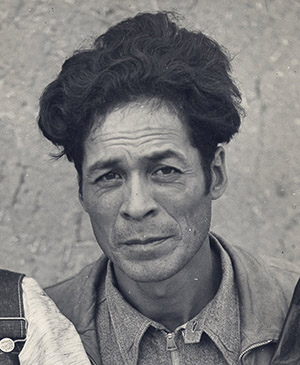
 |
 |
 |
 |
![]()
5. A Memory of Claus Adam
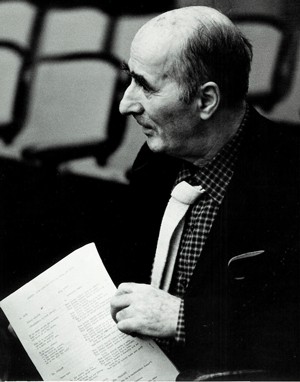 As
final thought, we would like to remember Claus Adam (1917-1983,)
best known as the cellist of the Juilliard String Quartet, who was one of the few people back in the 1970s to appreciate
this composition. He had become aware of New
Mexico’s rich culture because he was one of the earliest members of
the Santa Fe Chamber Music Festival. His Austrian father was an
ethnologist living in Indonesia when Claus was born. When he was six
they returned to Austria where he eventually studied at the
Mozarteum in Salzburg. In 1929 he immigrated to the USA and became a
naturalized citizen in 1935. For the last decade of his life, he
devoted himself to composing. His connection to ethnology, New
Mexico, and
composition are probably factors that led to his appreciation of
Land of Journeys’ Ending. Sadly, he passed away not long afterwards,
a musical personality missed to this day.
As
final thought, we would like to remember Claus Adam (1917-1983,)
best known as the cellist of the Juilliard String Quartet, who was one of the few people back in the 1970s to appreciate
this composition. He had become aware of New
Mexico’s rich culture because he was one of the earliest members of
the Santa Fe Chamber Music Festival. His Austrian father was an
ethnologist living in Indonesia when Claus was born. When he was six
they returned to Austria where he eventually studied at the
Mozarteum in Salzburg. In 1929 he immigrated to the USA and became a
naturalized citizen in 1935. For the last decade of his life, he
devoted himself to composing. His connection to ethnology, New
Mexico, and
composition are probably factors that led to his appreciation of
Land of Journeys’ Ending. Sadly, he passed away not long afterwards,
a musical personality missed to this day.
![]()
6. D
(The alabdo is taken from the John D. Robb field recordings
housed in the archives of the Center for Southwest Research at the
University of New Mexico.)
|
Movement I (begins with an Alabado) Por el rostro de la sangre Psalm XXII |
Movement I (begins with an Alabado) By the
trail of the blood |



